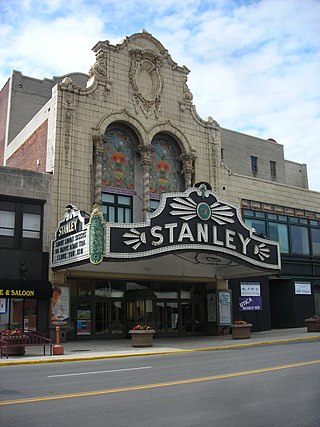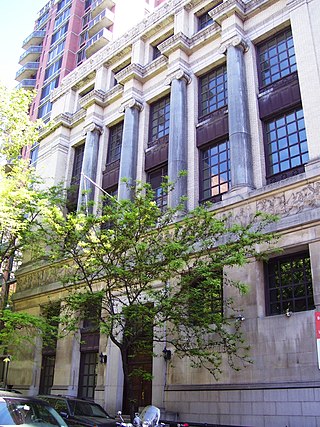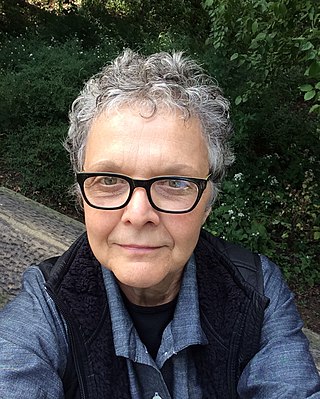
Utica is a city in the Mohawk Valley and the county seat of Oneida County, New York, United States. The tenth-most-populous city in New York State, its population was 65,283 in the 2020 U.S. Census. Located on the Mohawk River at the foot of the Adirondack Mountains, it is approximately 95 mi (153 km) west-northwest of Albany, 55 mi (89 km) east of Syracuse and 240 mi (386 km) northwest of New York City. Utica and the nearby city of Rome anchor the Utica–Rome Metropolitan Statistical Area comprising all of Oneida and Herkimer Counties.

The Hudson River School was a mid-19th-century American art movement embodied by a group of landscape painters whose aesthetic vision was influenced by Romanticism. Early on, the paintings typically depicted the Hudson River Valley and the surrounding area, including the Catskill, Adirondack, and White Mountains.

Pratt Institute is a private university with its main campus in Brooklyn, New York. It has a satellite campus in Manhattan and an extension campus in Utica, New York at the Munson-Williams-Proctor Arts Institute. The school was founded in 1887 with programs primarily in engineering, architecture, and fine arts. Comprising six schools, the institute is primarily known for its programs in architecture, graphic design, interior design, and industrial design.

The Adirondack Bank Center at the Utica Memorial Auditorium is a 3,860-seat multi-purpose arena in Utica, New York, with a capacity of 5,700 for concerts. Nicknamed the Aud, it is the home arena of the Utica Comets, the AHL affiliate of the NHL's New Jersey Devils, and Utica City FC of the MASL.

The Stanley Theatre is a historic Baroque movie palace in Utica, New York. Over the years, it has gone through several changes of ownership, but has always been affiliated with Warner Brothers Pictures.
Josiah McElheny is an artist and sculptor, primarily known for his work with glass blowing and assemblages of glass and mirrored glassed objects. He is a 2006 recipient of the MacArthur Fellows Program. He lives and works in New York City.
Karl Zerbe was a German-born American painter and educator.

The New York School of Applied Design for Women, established in 1892 by Ellen Dunlap Hopkins, was an early design school for women in New York City. The 1908 New York School of Applied Design building was designed by Harvey Wiley Corbett and is now landmarked.
Reginald Case was an American artist who made American Folk Art collages and Hollywood iconographic mixed-media assemblages and sculptures.
William T. Williams is an American painter and educator. He is known for his process-based approach to painting that engages motifs drawn from personal memory and cultural narrative to create non-referential, abstract compositions. He was a Professor of Art at Brooklyn College, City University of New York from 1971 to 2008.

Raymond Han was an American painter who was born in Honolulu, Hawaii, in 1931, and died in upstate New York in 2017. After study with Willson Young Stamper (1912–1988) at the Honolulu Museum of Art, Han moved to New York City and studied at the Art Students League of New York with Frank Mason and Robert Beverly Hale (1901–1985). Han lived and worked in upstate New York for the last period of his working life.

Fountain Elms is a historic home located at Utica in Oneida County, New York. It is part of the Munson-Williams-Proctor Arts Institute. The original block was completed in 1852 in the "Italian Style". It is basically a cube with a center hall plan. The original rear wing was remodeled in 1883 and a third two-story wing added. An additional wing and piazza were added in 1908, resulting in the current irregular plan.

William C. Palmer (1906–1987) was an American painter who created public murals.

William E. Haugaard was an American architect who served as the State Architect for the State of New York from 1928 to 1944. A number of his works have been listed on the National Register of Historic Places.

David True is an American painter, born in Marietta, Ohio. He received a BFA from Ohio University in 1966 and an MFA from Ohio University in 1967. In 1978, he was included in the New Image Painting exhibition at the Whitney Museum of American Art. He currently lives and paints in New York, and teaches at Cooper Union.

The Bradley & Hubbard Manufacturing Company (1852–1940) was formed in Meriden, Connecticut, and over the years produced Art Brass tables, call bells, candlestick holders, clocks, match safes, lamps, architectural grilles, railings, etc. Overall the company patented 238 designs and mechanical devices. "By the 1890s, the Bradley and Hubbard name was synonymous with high quality and artistic merit," said Richard E. Stamm for the Smithsonian Institution, which has an extensive collection of Bradley and Hubbard manufactured design objects in its collection.

Rose Marasco, is an American photographer. She is considered to be "perhaps Maine’s most prolific photographer,” living and working there since 1979.

Locking Piece is a sculpture by Henry Moore. It comprises two interlocking forms holding a third element between them, on a bronze base. It is usually mounted on a separate plinth. The sculpture was created in 1962–1964, and bronze casts were made in 1964–1967.
Grace A. Paull (1898–1990) was an American artist, illustrator, and author. She designed greeting cards, illustrated children's books, and painted people, landscapes and flowers.

Rodger Mack was an American sculptor, painter, ceramic artist and educator. He is best known for his large-scale bronze and steel sculptures. His works are featured in national and international museums and gallery collections including MACBA - Barcelona Museum of Contemporary Art, Arkansas Art Center, Stone Quarry Hill Art Park, the Oscar Krasner Gallery, and the Grand Valley State University collection.


















